Analysis of Project Management Skills: Leadership and Culture
VerifiedAdded on 2023/06/03
|7
|1829
|408
Report
AI Summary
This report delves into crucial project management skills, focusing on leadership, interpersonal dynamics, and cultural influences within a project setting. It begins by emphasizing the significance of leadership as a key interpersonal skill, illustrated with an example. The report then examines the application of personality traits, specifically power motivation, in leadership styles, supported by personal experiences. Furthermore, it analyzes effective meeting strategies from a leadership perspective, highlighting the importance of aligning employee interests with organizational goals. The report also explores the impact of different power types, such as extroversion, on project outcomes, weighing the pros and cons. Finally, it addresses the cultural pitfalls that can hinder teamwork, emphasizing the need for a unified organizational culture to achieve project objectives. The report provides real-world examples and references to support its analysis, making it a valuable resource for understanding and improving project management practices.
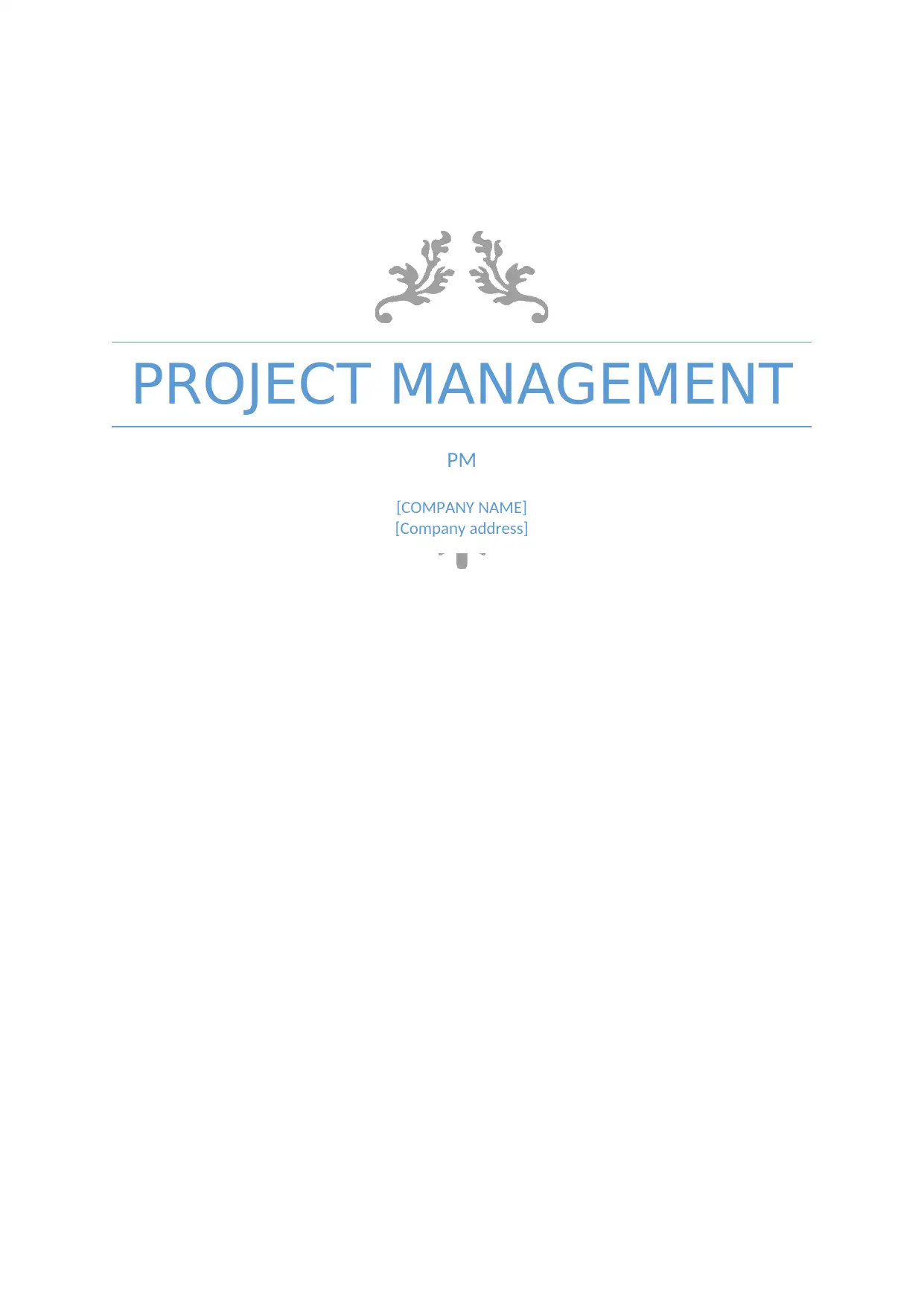
PROJECT MANAGEMENT
PM
[COMPANY NAME]
[Company address]
PM
[COMPANY NAME]
[Company address]
Paraphrase This Document
Need a fresh take? Get an instant paraphrase of this document with our AI Paraphraser
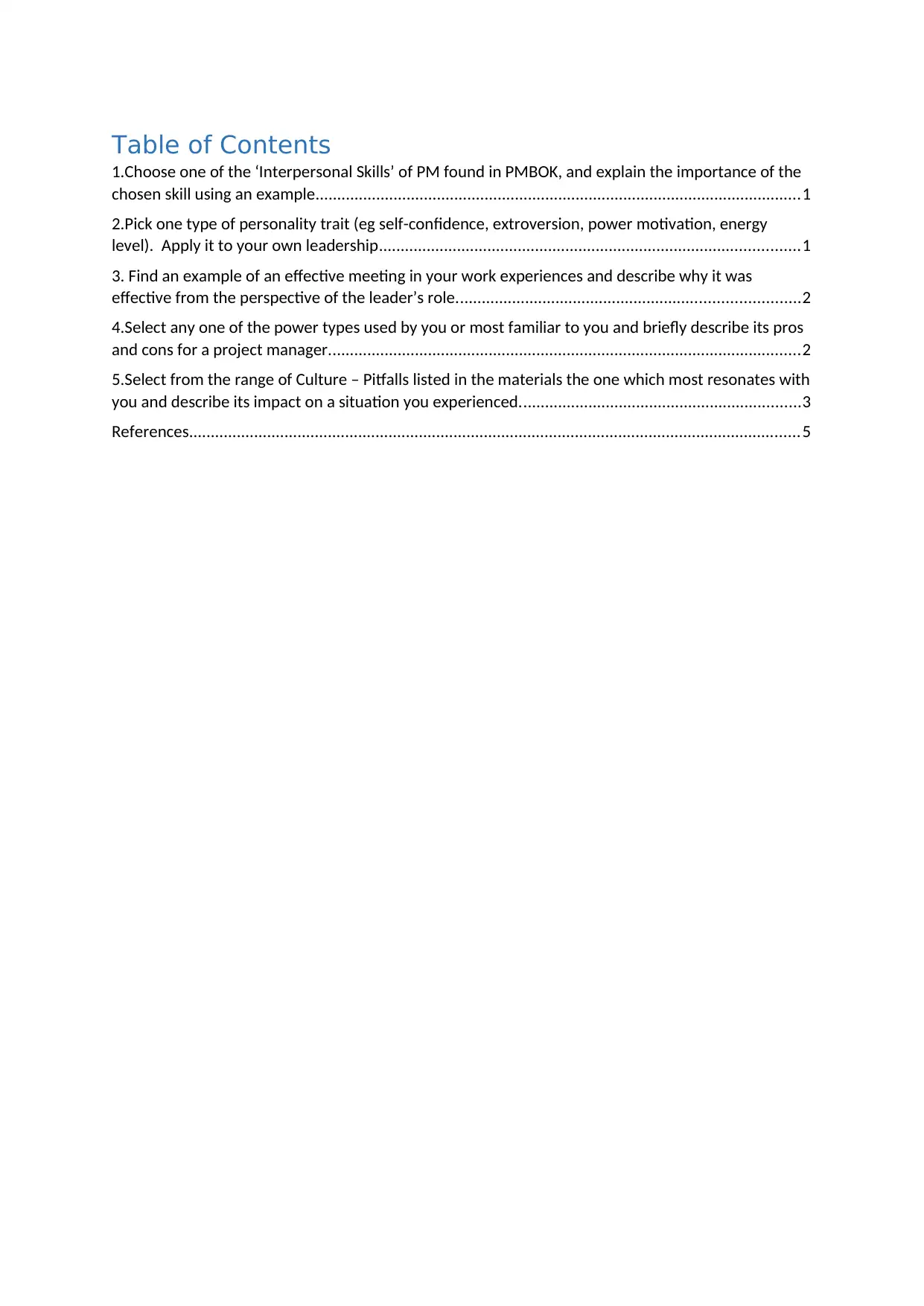
Table of Contents
1.Choose one of the ‘Interpersonal Skills’ of PM found in PMBOK, and explain the importance of the
chosen skill using an example................................................................................................................1
2.Pick one type of personality trait (eg self-confidence, extroversion, power motivation, energy
level). Apply it to your own leadership.................................................................................................1
3. Find an example of an effective meeting in your work experiences and describe why it was
effective from the perspective of the leader’s role...............................................................................2
4.Select any one of the power types used by you or most familiar to you and briefly describe its pros
and cons for a project manager.............................................................................................................2
5.Select from the range of Culture – Pitfalls listed in the materials the one which most resonates with
you and describe its impact on a situation you experienced.................................................................3
References.............................................................................................................................................5
1.Choose one of the ‘Interpersonal Skills’ of PM found in PMBOK, and explain the importance of the
chosen skill using an example................................................................................................................1
2.Pick one type of personality trait (eg self-confidence, extroversion, power motivation, energy
level). Apply it to your own leadership.................................................................................................1
3. Find an example of an effective meeting in your work experiences and describe why it was
effective from the perspective of the leader’s role...............................................................................2
4.Select any one of the power types used by you or most familiar to you and briefly describe its pros
and cons for a project manager.............................................................................................................2
5.Select from the range of Culture – Pitfalls listed in the materials the one which most resonates with
you and describe its impact on a situation you experienced.................................................................3
References.............................................................................................................................................5
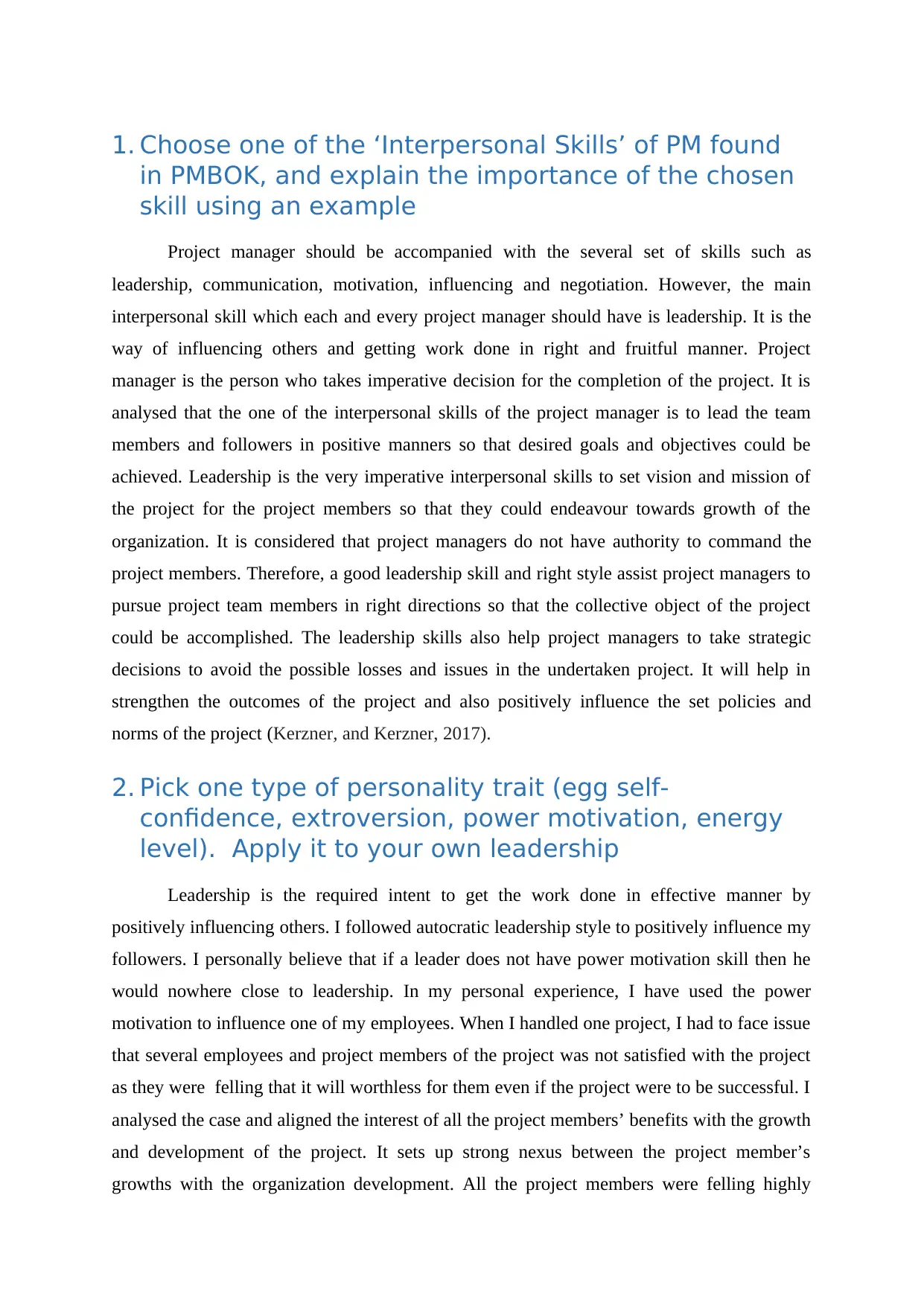
1. Choose one of the ‘Interpersonal Skills’ of PM found
in PMBOK, and explain the importance of the chosen
skill using an example
Project manager should be accompanied with the several set of skills such as
leadership, communication, motivation, influencing and negotiation. However, the main
interpersonal skill which each and every project manager should have is leadership. It is the
way of influencing others and getting work done in right and fruitful manner. Project
manager is the person who takes imperative decision for the completion of the project. It is
analysed that the one of the interpersonal skills of the project manager is to lead the team
members and followers in positive manners so that desired goals and objectives could be
achieved. Leadership is the very imperative interpersonal skills to set vision and mission of
the project for the project members so that they could endeavour towards growth of the
organization. It is considered that project managers do not have authority to command the
project members. Therefore, a good leadership skill and right style assist project managers to
pursue project team members in right directions so that the collective object of the project
could be accomplished. The leadership skills also help project managers to take strategic
decisions to avoid the possible losses and issues in the undertaken project. It will help in
strengthen the outcomes of the project and also positively influence the set policies and
norms of the project (Kerzner, and Kerzner, 2017).
2. Pick one type of personality trait (egg self-
confidence, extroversion, power motivation, energy
level). Apply it to your own leadership
Leadership is the required intent to get the work done in effective manner by
positively influencing others. I followed autocratic leadership style to positively influence my
followers. I personally believe that if a leader does not have power motivation skill then he
would nowhere close to leadership. In my personal experience, I have used the power
motivation to influence one of my employees. When I handled one project, I had to face issue
that several employees and project members of the project was not satisfied with the project
as they were felling that it will worthless for them even if the project were to be successful. I
analysed the case and aligned the interest of all the project members’ benefits with the growth
and development of the project. It sets up strong nexus between the project member’s
growths with the organization development. All the project members were felling highly
in PMBOK, and explain the importance of the chosen
skill using an example
Project manager should be accompanied with the several set of skills such as
leadership, communication, motivation, influencing and negotiation. However, the main
interpersonal skill which each and every project manager should have is leadership. It is the
way of influencing others and getting work done in right and fruitful manner. Project
manager is the person who takes imperative decision for the completion of the project. It is
analysed that the one of the interpersonal skills of the project manager is to lead the team
members and followers in positive manners so that desired goals and objectives could be
achieved. Leadership is the very imperative interpersonal skills to set vision and mission of
the project for the project members so that they could endeavour towards growth of the
organization. It is considered that project managers do not have authority to command the
project members. Therefore, a good leadership skill and right style assist project managers to
pursue project team members in right directions so that the collective object of the project
could be accomplished. The leadership skills also help project managers to take strategic
decisions to avoid the possible losses and issues in the undertaken project. It will help in
strengthen the outcomes of the project and also positively influence the set policies and
norms of the project (Kerzner, and Kerzner, 2017).
2. Pick one type of personality trait (egg self-
confidence, extroversion, power motivation, energy
level). Apply it to your own leadership
Leadership is the required intent to get the work done in effective manner by
positively influencing others. I followed autocratic leadership style to positively influence my
followers. I personally believe that if a leader does not have power motivation skill then he
would nowhere close to leadership. In my personal experience, I have used the power
motivation to influence one of my employees. When I handled one project, I had to face issue
that several employees and project members of the project was not satisfied with the project
as they were felling that it will worthless for them even if the project were to be successful. I
analysed the case and aligned the interest of all the project members’ benefits with the growth
and development of the project. It sets up strong nexus between the project member’s
growths with the organization development. All the project members were felling highly
⊘ This is a preview!⊘
Do you want full access?
Subscribe today to unlock all pages.

Trusted by 1+ million students worldwide
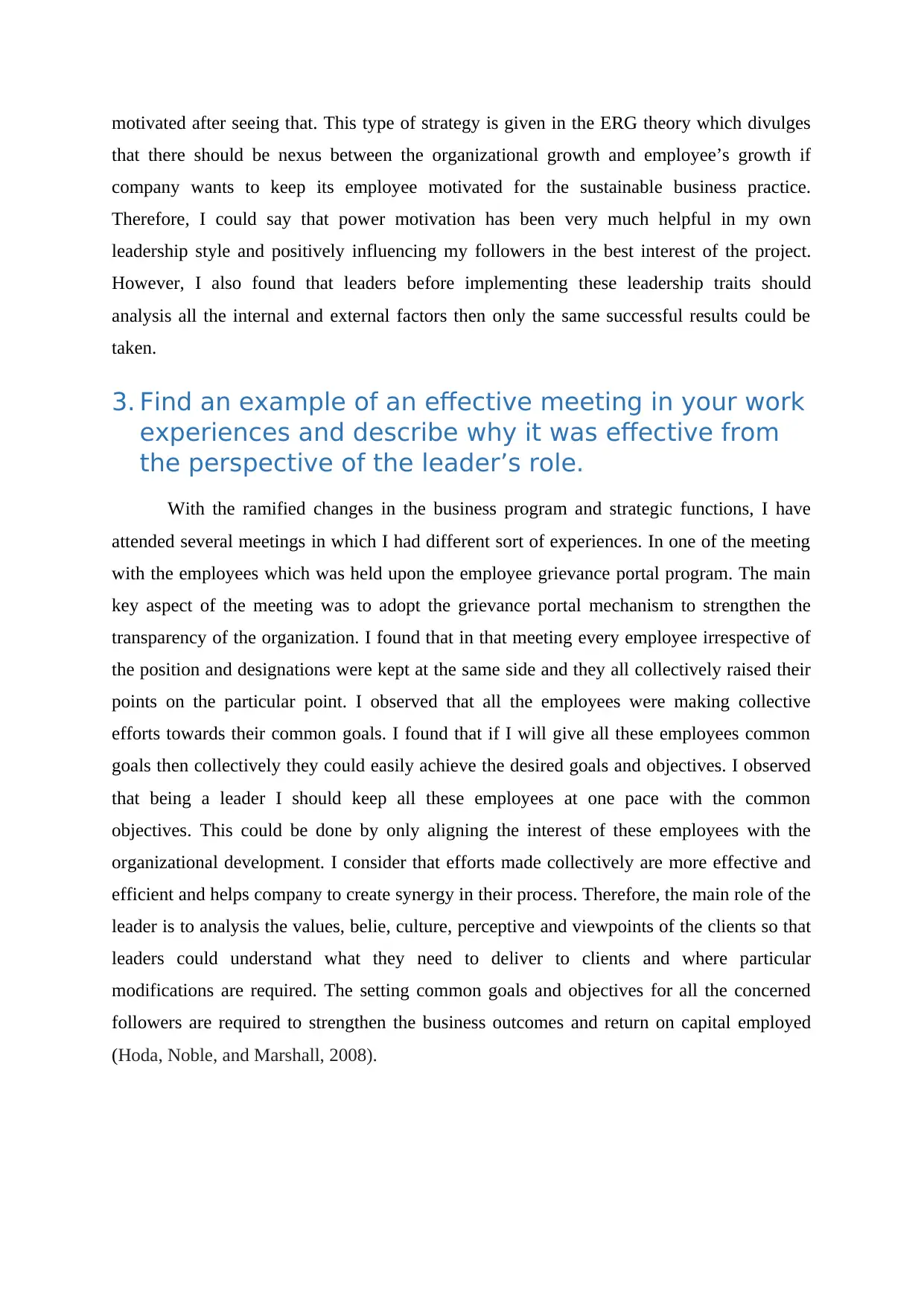
motivated after seeing that. This type of strategy is given in the ERG theory which divulges
that there should be nexus between the organizational growth and employee’s growth if
company wants to keep its employee motivated for the sustainable business practice.
Therefore, I could say that power motivation has been very much helpful in my own
leadership style and positively influencing my followers in the best interest of the project.
However, I also found that leaders before implementing these leadership traits should
analysis all the internal and external factors then only the same successful results could be
taken.
3. Find an example of an effective meeting in your work
experiences and describe why it was effective from
the perspective of the leader’s role.
With the ramified changes in the business program and strategic functions, I have
attended several meetings in which I had different sort of experiences. In one of the meeting
with the employees which was held upon the employee grievance portal program. The main
key aspect of the meeting was to adopt the grievance portal mechanism to strengthen the
transparency of the organization. I found that in that meeting every employee irrespective of
the position and designations were kept at the same side and they all collectively raised their
points on the particular point. I observed that all the employees were making collective
efforts towards their common goals. I found that if I will give all these employees common
goals then collectively they could easily achieve the desired goals and objectives. I observed
that being a leader I should keep all these employees at one pace with the common
objectives. This could be done by only aligning the interest of these employees with the
organizational development. I consider that efforts made collectively are more effective and
efficient and helps company to create synergy in their process. Therefore, the main role of the
leader is to analysis the values, belie, culture, perceptive and viewpoints of the clients so that
leaders could understand what they need to deliver to clients and where particular
modifications are required. The setting common goals and objectives for all the concerned
followers are required to strengthen the business outcomes and return on capital employed
(Hoda, Noble, and Marshall, 2008).
that there should be nexus between the organizational growth and employee’s growth if
company wants to keep its employee motivated for the sustainable business practice.
Therefore, I could say that power motivation has been very much helpful in my own
leadership style and positively influencing my followers in the best interest of the project.
However, I also found that leaders before implementing these leadership traits should
analysis all the internal and external factors then only the same successful results could be
taken.
3. Find an example of an effective meeting in your work
experiences and describe why it was effective from
the perspective of the leader’s role.
With the ramified changes in the business program and strategic functions, I have
attended several meetings in which I had different sort of experiences. In one of the meeting
with the employees which was held upon the employee grievance portal program. The main
key aspect of the meeting was to adopt the grievance portal mechanism to strengthen the
transparency of the organization. I found that in that meeting every employee irrespective of
the position and designations were kept at the same side and they all collectively raised their
points on the particular point. I observed that all the employees were making collective
efforts towards their common goals. I found that if I will give all these employees common
goals then collectively they could easily achieve the desired goals and objectives. I observed
that being a leader I should keep all these employees at one pace with the common
objectives. This could be done by only aligning the interest of these employees with the
organizational development. I consider that efforts made collectively are more effective and
efficient and helps company to create synergy in their process. Therefore, the main role of the
leader is to analysis the values, belie, culture, perceptive and viewpoints of the clients so that
leaders could understand what they need to deliver to clients and where particular
modifications are required. The setting common goals and objectives for all the concerned
followers are required to strengthen the business outcomes and return on capital employed
(Hoda, Noble, and Marshall, 2008).
Paraphrase This Document
Need a fresh take? Get an instant paraphrase of this document with our AI Paraphraser
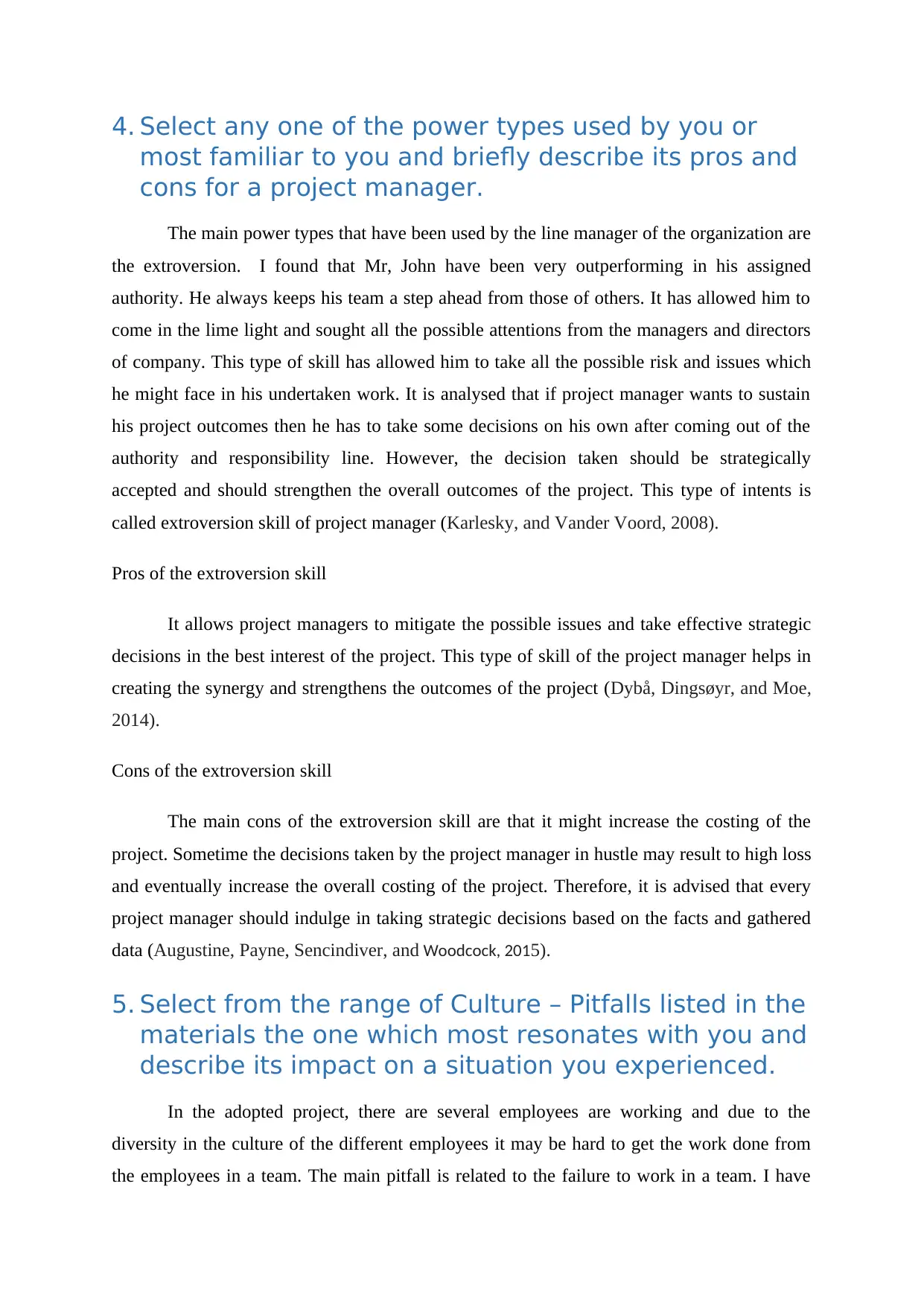
4. Select any one of the power types used by you or
most familiar to you and briefly describe its pros and
cons for a project manager.
The main power types that have been used by the line manager of the organization are
the extroversion. I found that Mr, John have been very outperforming in his assigned
authority. He always keeps his team a step ahead from those of others. It has allowed him to
come in the lime light and sought all the possible attentions from the managers and directors
of company. This type of skill has allowed him to take all the possible risk and issues which
he might face in his undertaken work. It is analysed that if project manager wants to sustain
his project outcomes then he has to take some decisions on his own after coming out of the
authority and responsibility line. However, the decision taken should be strategically
accepted and should strengthen the overall outcomes of the project. This type of intents is
called extroversion skill of project manager (Karlesky, and Vander Voord, 2008).
Pros of the extroversion skill
It allows project managers to mitigate the possible issues and take effective strategic
decisions in the best interest of the project. This type of skill of the project manager helps in
creating the synergy and strengthens the outcomes of the project (Dybå, Dingsøyr, and Moe,
2014).
Cons of the extroversion skill
The main cons of the extroversion skill are that it might increase the costing of the
project. Sometime the decisions taken by the project manager in hustle may result to high loss
and eventually increase the overall costing of the project. Therefore, it is advised that every
project manager should indulge in taking strategic decisions based on the facts and gathered
data (Augustine, Payne, Sencindiver, and Woodcock, 2015).
5. Select from the range of Culture – Pitfalls listed in the
materials the one which most resonates with you and
describe its impact on a situation you experienced.
In the adopted project, there are several employees are working and due to the
diversity in the culture of the different employees it may be hard to get the work done from
the employees in a team. The main pitfall is related to the failure to work in a team. I have
most familiar to you and briefly describe its pros and
cons for a project manager.
The main power types that have been used by the line manager of the organization are
the extroversion. I found that Mr, John have been very outperforming in his assigned
authority. He always keeps his team a step ahead from those of others. It has allowed him to
come in the lime light and sought all the possible attentions from the managers and directors
of company. This type of skill has allowed him to take all the possible risk and issues which
he might face in his undertaken work. It is analysed that if project manager wants to sustain
his project outcomes then he has to take some decisions on his own after coming out of the
authority and responsibility line. However, the decision taken should be strategically
accepted and should strengthen the overall outcomes of the project. This type of intents is
called extroversion skill of project manager (Karlesky, and Vander Voord, 2008).
Pros of the extroversion skill
It allows project managers to mitigate the possible issues and take effective strategic
decisions in the best interest of the project. This type of skill of the project manager helps in
creating the synergy and strengthens the outcomes of the project (Dybå, Dingsøyr, and Moe,
2014).
Cons of the extroversion skill
The main cons of the extroversion skill are that it might increase the costing of the
project. Sometime the decisions taken by the project manager in hustle may result to high loss
and eventually increase the overall costing of the project. Therefore, it is advised that every
project manager should indulge in taking strategic decisions based on the facts and gathered
data (Augustine, Payne, Sencindiver, and Woodcock, 2015).
5. Select from the range of Culture – Pitfalls listed in the
materials the one which most resonates with you and
describe its impact on a situation you experienced.
In the adopted project, there are several employees are working and due to the
diversity in the culture of the different employees it may be hard to get the work done from
the employees in a team. The main pitfall is related to the failure to work in a team. I have
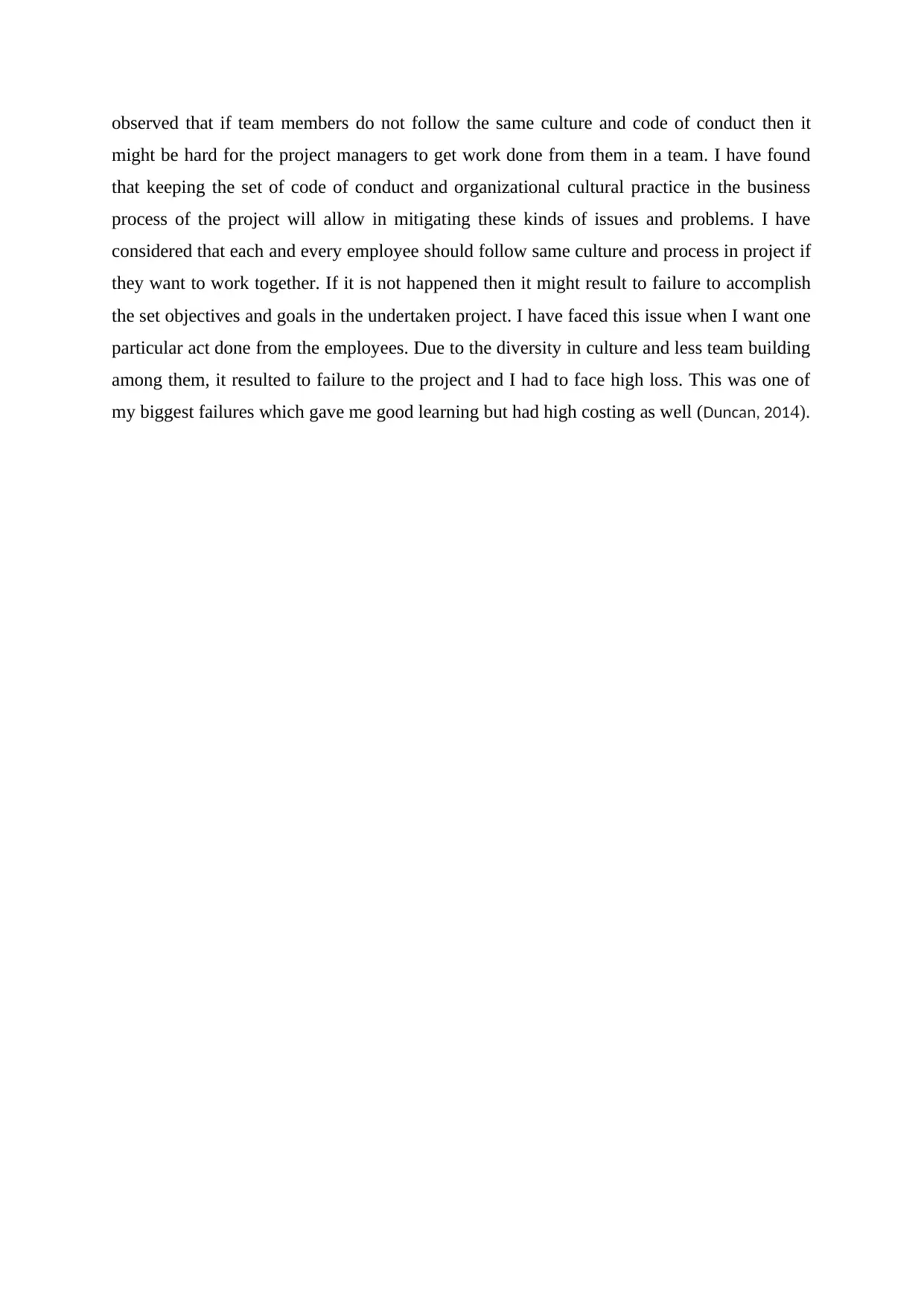
observed that if team members do not follow the same culture and code of conduct then it
might be hard for the project managers to get work done from them in a team. I have found
that keeping the set of code of conduct and organizational cultural practice in the business
process of the project will allow in mitigating these kinds of issues and problems. I have
considered that each and every employee should follow same culture and process in project if
they want to work together. If it is not happened then it might result to failure to accomplish
the set objectives and goals in the undertaken project. I have faced this issue when I want one
particular act done from the employees. Due to the diversity in culture and less team building
among them, it resulted to failure to the project and I had to face high loss. This was one of
my biggest failures which gave me good learning but had high costing as well (Duncan, 2014).
might be hard for the project managers to get work done from them in a team. I have found
that keeping the set of code of conduct and organizational cultural practice in the business
process of the project will allow in mitigating these kinds of issues and problems. I have
considered that each and every employee should follow same culture and process in project if
they want to work together. If it is not happened then it might result to failure to accomplish
the set objectives and goals in the undertaken project. I have faced this issue when I want one
particular act done from the employees. Due to the diversity in culture and less team building
among them, it resulted to failure to the project and I had to face high loss. This was one of
my biggest failures which gave me good learning but had high costing as well (Duncan, 2014).
⊘ This is a preview!⊘
Do you want full access?
Subscribe today to unlock all pages.

Trusted by 1+ million students worldwide
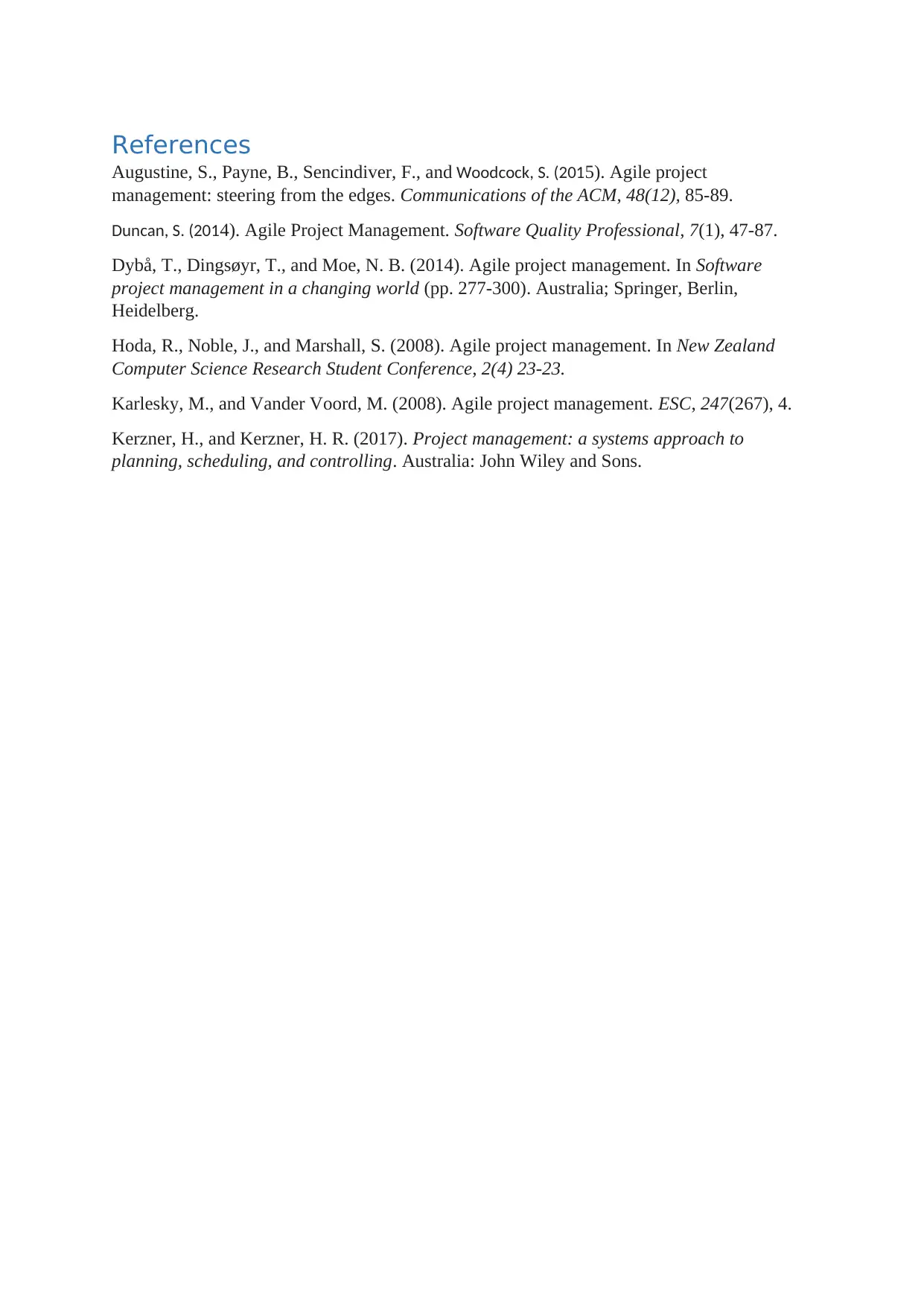
References
Augustine, S., Payne, B., Sencindiver, F., and Woodcock, S. (2015). Agile project
management: steering from the edges. Communications of the ACM, 48(12), 85-89.
Duncan, S. (2014). Agile Project Management. Software Quality Professional, 7(1), 47-87.
Dybå, T., Dingsøyr, T., and Moe, N. B. (2014). Agile project management. In Software
project management in a changing world (pp. 277-300). Australia; Springer, Berlin,
Heidelberg.
Hoda, R., Noble, J., and Marshall, S. (2008). Agile project management. In New Zealand
Computer Science Research Student Conference, 2(4) 23-23.
Karlesky, M., and Vander Voord, M. (2008). Agile project management. ESC, 247(267), 4.
Kerzner, H., and Kerzner, H. R. (2017). Project management: a systems approach to
planning, scheduling, and controlling. Australia: John Wiley and Sons.
Augustine, S., Payne, B., Sencindiver, F., and Woodcock, S. (2015). Agile project
management: steering from the edges. Communications of the ACM, 48(12), 85-89.
Duncan, S. (2014). Agile Project Management. Software Quality Professional, 7(1), 47-87.
Dybå, T., Dingsøyr, T., and Moe, N. B. (2014). Agile project management. In Software
project management in a changing world (pp. 277-300). Australia; Springer, Berlin,
Heidelberg.
Hoda, R., Noble, J., and Marshall, S. (2008). Agile project management. In New Zealand
Computer Science Research Student Conference, 2(4) 23-23.
Karlesky, M., and Vander Voord, M. (2008). Agile project management. ESC, 247(267), 4.
Kerzner, H., and Kerzner, H. R. (2017). Project management: a systems approach to
planning, scheduling, and controlling. Australia: John Wiley and Sons.
1 out of 7
Related Documents
Your All-in-One AI-Powered Toolkit for Academic Success.
+13062052269
info@desklib.com
Available 24*7 on WhatsApp / Email
![[object Object]](/_next/static/media/star-bottom.7253800d.svg)
Unlock your academic potential
Copyright © 2020–2025 A2Z Services. All Rights Reserved. Developed and managed by ZUCOL.




